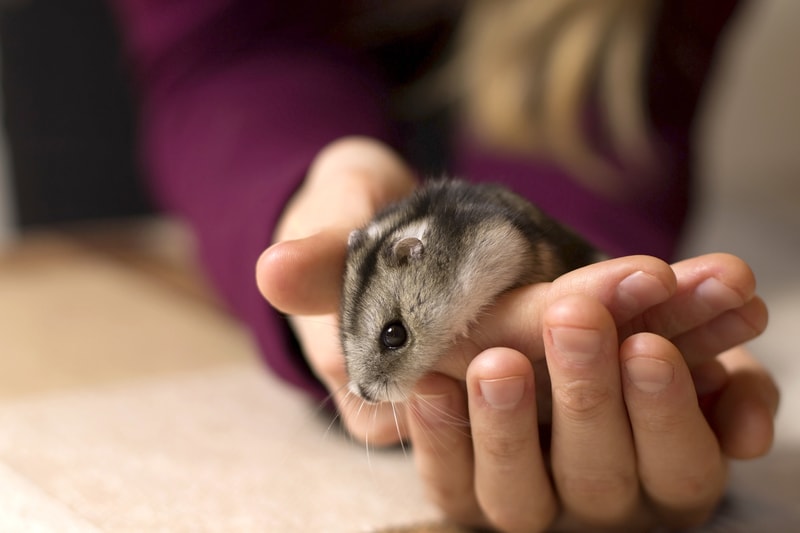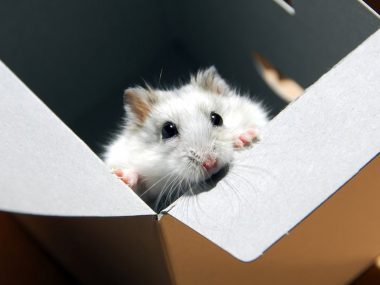Chess and Monopoly are far too boring for your curious little hamster pal! When choosing games to play with your pocket-sized pet, you need to focus on stimulating activities that give you time to bond while it explores. Planning play times can be fun, but you must keep a few things in mind.
12 Tips when playing with your hamster:
- Move slowly
- Stay close to the ground
- Let new hamsters settle
- Always supervise
- Keep playtimes short
- Watch its body language
- Don’t wake it up
- Know what to expect from the breed
- Toys must be clean and safe
- Make regular playtimes
- Give rewards
- Make playtime fun
Hamsters are naturally curious and energetic, so regular play times are an excellent way for owners to engage with their little munchkins. Let’s go through some things you should remember so you and your hamster can have fun together.
Table of Contents
Things To Remember When Playing With A Hamster
Your hamster also needs a stimulating cage environment with lots of interesting things and a selection of hamster toys to keep it busy when you’re not around. However, regular playtimes with your hamster outside its cage are important for you and your pet to bond.
12 Tips To Make Playtime With Your Hamster Fun
- Remember that a hamster can’t see well – Hammie’s bright, sparkling little eyes are cute, but they aren’t terribly effective. Your small pet relies more on smell and touching things with its whiskers than eyesight, so try not to make any sudden moves that could startle it and always let it sniff your hand before picking it up.
- Keep all activities close to the ground – Cuddle time with your hamster is special, but keep in mind that they may make a dash for something interesting. If you are standing or your activity is on a table, your fragile little pet could fall.
An excellent place to play with your hamster is inside an empty bathtub. Put the plug in and lay a towel on the bottom. Then hop in and let your hamster run around on you, or put hamster toys or activities on the towel and let your little pal explore without stressing that it’s going to chew its way out and vanish under a cupboard. - Give new hamsters time to settle in – Getting a new pet is always exciting, and you may be eager to play with your cute fluff bundle. Changing homes is a big adjustment for the little animal, so first, focus on letting your pet get used to the sound of your voice and scent. You should only try to handle your hamster when it has settled in and relaxed.
A great idea is to wipe your hands on a paper towel and put it into your new hamster’s cage. This tip also works if your hamster sometimes bites you.Hammie will most likely chew it up, but at the same time, it will get to know your scent and realize that you’re its friend. - Always supervise during playtime – Like any toddler parent, you must always watch your busy bee. Never leave your hamster out of its cage unless you can give it your undivided attention. In a blink of an eye, your hammie could escape from its play area and get into trouble.
- Keep play sessions short – Although your hamster will enjoy its playtime with you, keep it short. It should get enough stimulation, but then it must return to its safe cage for refreshments and rest. A maximum of 10 to 15 minutes is long enough for each play session.
- Watch your hamster’s body language – Hammies can’t talk, but they do communicate if you know what signs to look for. Play times must always be fun for the little animal. If your hamster doesn’t want to play, don’t force it. It may be sleepy or scared of something.
- Don’t wake your hamster up to play – Sleeping is one of a hamster’s favorite daytime activities. Hamsters are mostly nocturnal, so give your buddy a break in the day if you notice it snoozing. They do wake up periodically to have a quick snack or take a drink, but they may not be as curious or active as they are in the early evening.

- Understand your hamster breed – Some breeds enjoy playtimes more than others. Syrian hamsters enjoy their interactions with their owners and get used to playtime faster than a Campbell’s Dwarf Hamster or Roborovski Hamster. The tiny breeds are also quite tricky to handle and hold because of their size, and they can move very quickly.
So, it is essential to understand the characteristics of the hamster breed you’ve got. Some hammies may need a little extra time to warm up to their special human than others. - Check that all toys are clean and safe – You don’t need a lot of extra equipment to play with your hamster. Tunnels, obstacles, and hamster mazes are easy to create, and it is fun to watch your hamster enjoying the activity.
Although you can use things you find around the house to play with your hamster, always have safety in mind. Items like foam balls or wood that can splinter are NOT hammie safe. Always ensure that all items are clean before letting your hamster explore them. - Make playtimes a daily activity – Your hamster may be cautious and a little reserved the first few times you want to play with it, but if you make the outings a daily occurrence, it will quickly start looking forward to the playtime.
- Make playtimes fun by giving rewards – Of course, you can’t give your clever hammie a certificate or trophy for completing an obstacle course or maze, but you can give it a special snack. Treats are also an excellent way to encourage a shy hamster to move around more.
Healthy treats for your hamster can include bits of fruit or vegetables, or you can purchase snacks like Kaytee Food From The Wild Natural Snack to keep as playtime rewards. - Playtime must always be fun – If you are feeling bothered or rushed, or your hammie doesn’t look like he wants to be picked up at playtime, it is better just to change the cage setup to add some different toys. Never force a hamster to play or chase it around its cage to pick it up. It may be scared or not feeling well.
Many hamster parents keep a few extra toys to swap out to provide extra stimulation. There are plenty of hamster boredom buster ideas online that you can make for your hamster.
Frequently Asked Questions
Do Hamsters Like Being Played With?
Like people, hamsters have different personalities. Most hamsters enjoy regular playtimes, especially with only one or two people they are used to. After all, you wouldn’t like to be suddenly picked up by a giant you don’t know, and it is the same for your little pet.
Once your hamster knows your voice and realizes that the interactions will mean stimulation, fun, and possibly some treats, it will look forward to its playtime. If you are wondering if your hamster likes you, look out for these 7 signs of affection.
What Activities Can I Do With My Hamster?
Although you can’t play rough and tumble games with your tiny hamster, you can let it run over your body. It is simple to build a small maze or obstacle course. Remember that hamsters love to climb and explore, so give it some climbing rope or connect a few cardboard tubes and make a tunnel for it to crawl through.
Watching your hamster explore different textures can also be fun. Your hammie will love digging! In addition to its sand bath, try giving it a container of sterilized potting soil (that is a particular type of soil that doesn’t contain fertilizer). While playing with your pet, don’t forget to take plenty of selfies with your furball so you can show off its cuteness to your friends.
What Don’t Hamsters Like?
Hamsters don’t like being woken up, loud noises, or situations that make them feel scared. So keep the playtime environment quiet and reassuring, so your hamster can explore confidently and focus on the activity rather than looking for a place to hide or biting because it’s afraid.
Although hamsters usually prefer their own company, they can get used to, and may look forward to interacting with their adoring owner. However, they must never be put together with other animals like guinea pigs or rabbits, even for playtime. They are entirely different species, and it would be highly stressful or even dangerous for the hamster.
How Do You Know When Your Hamster Wants To Play?
Once you have set up a regular play routine, your hamster may start anticipating the interaction with you. You can take your hamster out to play if it is alert and seems eager to be picked up. If you notice that your hamster comes out of its house or moves towards you when you come towards the cage, it is a sign that your pocket-sized pet is ready to have fun and play!
References:
https://animals.mom.com/build-hamster-toys-out-household-items-4565.html
https://www.petmd.com/exotic/evr_ex_hm_five-most-popular-hamster-breeds






